监控新星 | 实战Prometheus搭建监控系统

Prometheus是一款基于时序数据库的开源监控告警系统,说起Prometheus则不得不提SoundCloud,这是一个在线音乐分享的平台,类似于做视频分享的YouTube,由于他们在微服务架构的道路上越走越远,出现了成百上千的服务,使用传统的监控系统StatsD和Graphite存在大量的局限性,于是他们在2012年开始着手开发一套全新的监控系统。Prometheus的原作者是Matt T. Proud,他也是在2012年加入SoundCloud的,实际上,在加入SoundCloud之前,Matt一直就职于Google,他从Google的集群管理器Borg和它的监控系统Borgmon中获取灵感,开发了开源的监控系统Prometheus,和Google的很多项目一样,使用的编程语言是Go。
很显然,Prometheus作为一个微服务架构监控系统的解决方案,它和容器也脱不开关系。早在2006年8月9日,Eric Schmidt在搜索引擎大会上首次提出了云计算(Cloud Computing)的概念,在之后的十几年里,云计算的发展势如破竹。在2013年,Pivotal的Matt Stine又提出了云原生(Cloud Native)的概念,云原生由微服务架构、DevOps和以容器为代表的敏捷基础架构组成,帮助企业快速、持续、可靠、规模化地交付软件。为了统一云计算接口和相关标准,2015年7月,隶属于Linux基金会的云原生计算基金会(CNCF,Cloud Native Computing Foundation)应运而生。第一个加入CNCF的项目是Google的Kubernetes,而Prometheus是第二个加入的(2016 年)。
目前Prometheus已经广泛用于Kubernetes集群的监控系统中,对Prometheus的历史感兴趣的同学可以看看SoundCloud的工程师Tobias Schmidt在2016年的PromCon大会上的演讲:The History of Prometheus at SoundCloud。
一、Prometheus概述
A multi-dimensional data model, so that data can be sliced and diced at will, along dimensions like instance, service, endpoint, and method. Operational simplicity, so that you can spin up a monitoring server where and when you want, even on your local workstation, without setting up a distributed storage backend or reconfiguring the world. Scalable data collection and decentralized architecture, so that you can reliably monitor the many instances of your services, and independent teams can set up independent monitoring servers. Finally, a powerful query language that leverages the data model for meaningful alerting (including easy silencing) and graphing (for dashboards and for ad-hoc exploration).
多维度数据模型
方便的部署和维护
灵活的数据采集
强大的查询语言
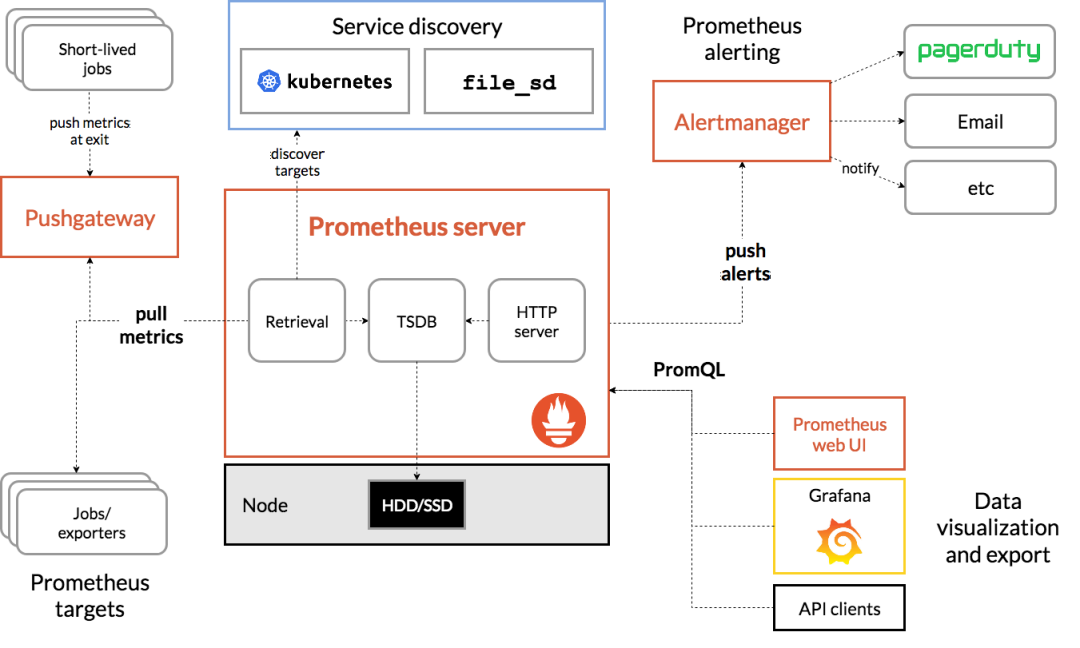
二、安装Prometheus server
2.1 开箱即用
$ wget https://github.com/prometheus/prometheus/releases/download/v2.4.3/prometheus-2.4.3.linux-amd64.tar.gz$ tar xvfz prometheus-2.4.3.linux-amd64.tar.gz
cd prometheus-2.4.3.linux-amd64./prometheus --versionprometheus, version 2.4.3 (branch: HEAD, revision: 167a4b4e73a8eca8df648d2d2043e21bdb9a7449)build user: root@1e42b46043e9build date: 20181004-08:42:02go version: go1.11.1
./prometheus --config.file=prometheus.yml sudo docker run -d -p 9090:9090 prom/prometheus$ sudo docker run -d -p 9090:9090 \ -v ~/docker/prometheus/:/etc/prometheus/ \ prom/prometheus~/docker/prometheus/prometheus.yml,这样可以方便编辑和查看,通过-v参数将本地的配置文件挂载到/etc/prometheus/位置,这是prometheus在容器中默认加载的配置文件位置。如果我们不确定默认的配置文件在哪,可以先执行上面的不带-v参数的命令,然后通过docker inspect命名看看容器在运行时默认的参数有哪些(下面的Args参数):$ sudo docker inspect 0c[]"Id": "0c4c2d0eed938395bcecf1e8bb4b6b87091fc4e6385ce5b404b6bb7419010f46","Created": "2018-10-15T22:27:34.56050369Z","Path": "/bin/prometheus","Args": ["--config.file=/etc/prometheus/prometheus.yml","--storage.tsdb.path=/prometheus","--web.console.libraries=/usr/share/prometheus/console_libraries","--web.console.templates=/usr/share/prometheus/consoles"],[]
2.3 配置Prometheus
--config.file来指定,配置文件格式为YAML。我们可以打开默认的配置文件prometheus.yml看下里面的内容:/etc/prometheus $ cat prometheus.yml# my global configglobal:scrape_interval: 15s # Set the scrape interval to every 15 seconds. Default is every 1 minute.evaluation_interval: 15s # Evaluate rules every 15 seconds. The default is every 1 minute.# scrape_timeout is set to the global default (10s).# Alertmanager configurationalerting:alertmanagers:- static_configs:- targets:# - alertmanager:9093# Load rules once and periodically evaluate them according to the global 'evaluation_interval'.rule_files:# - "first_rules.yml"# - "second_rules.yml"# A scrape configuration containing exactly one endpoint to scrape:# Here it's Prometheus itself.scrape_configs:# The job name is added as a label `job=<job_name>` to any timeseries scraped from this config.- job_name: 'prometheus'# metrics_path defaults to '/metrics'# scheme defaults to 'http'.static_configs:- targets: ['localhost:9090']
global块:Prometheus的全局配置,比如
scrape_interval表示Prometheus多久抓取一次数据,evaluation_interval表示多久检测一次告警规则;alerting块:关于Alertmanager的配置,这个我们后面再看;
rule_files块:告警规则,这个我们后面再看;
scrape_config 块:这里定义了Prometheus要抓取的目标,我们可以看到默认已经配置了一个名称为
prometheus的job,这是因为Prometheus在启动的时候也会通过HTTP接口暴露自身的指标数据,这就相当于Prometheus自己监控自己,虽然这在真正使用Prometheus时没啥用处,但是我们可以通过这个例子来学习如何使用Prometheus;可以访问http://localhost:9090/metrics查看Prometheus暴露了哪些指标;
三、学习PromQL
http://localhost:9090/即可,它默认会跳转到Graph页面:
promhttp_metric_handler_requests_total,这个指标表示/metrics页面的访问次数,Prometheus就是通过这个页面来抓取自身的监控数据的。在Console标签中查询结果如下:
scrape_interval参数是15s,也就是说Prometheus每15s访问一次/metrics页面,所以我们过15s刷新下页面,可以看到指标值会自增。在Graph标签中可以看得更明显:
3.1 数据模型
promhttp_metric_handler_requests_total{code="200",instance="192.168.0.107:9090",job="prometheus"} 106promhttp_metric_handler_requests_total,并且包含三个标签code、instance和job,这条记录的值为106。上面说过,Prometheus是一个时序数据库,相同指标相同标签的数据构成一条时间序列。如果以传统数据库的概念来理解时序数据库,可以把指标名当作表名,标签是字段,timestamp是主键,还有一个float64类型的字段表示值(Prometheus里面所有值都是按float64存储)。Counter
Gauge
Histogram
Summary
3.2 PromQL入门
# 表示 Prometheus 能否抓取 target 的指标,用于 target 的健康检查up
up{instance="192.168.0.107:9090",job="prometheus"} 1up{instance="192.168.0.108:9090",job="prometheus"} 1up{instance="192.168.0.107:9100",job="server"} 1up{instance="192.168.0.108:9104",job="mysql"} 0
up{job="prometheus"}=号,还可以使用!=、=~、!~,比如下面这样:up{job!="prometheus"}up{job=~"server|mysql"}up{job=~"192\.168\.0\.107.+"}
=~ 是根据正则表达式来匹配,必须符合RE2的语法。http_requests_total[5m]Range vector,没办法在Graph上显示成曲线图,一般情况下,会用在Counter类型的指标上,并和rate()或irate()函数一起使用(注意rate和irate的区别)。计算的是每秒的平均值,适用于变化很慢的 counterper-second average rate of increase, for slow-moving countersrate(http_requests_total[5m])# 计算的是每秒瞬时增加速率,适用于变化很快的 counterper-second instant rate of increase, for volatile and fast-moving countersirate(http_requests_total[5m])
count、sum、min、max、topk等 聚合操作,还支持rate、abs、ceil、floor等一堆的 内置函数,更多的例子,还是上官网学习吧。如果感兴趣,我们还可以把PromQL和SQL做一个对比,会发现PromQL语法更简洁,查询性能也更高。3.3 HTTP API
GET /api/v1/query
GET /api/v1/query_range
GET /api/v1/series
GET /api/v1/label/<label_name>/values
GET /api/v1/targets
GET /api/v1/rules
GET /api/v1/alerts
GET /api/v1/targets/metadata
GET /api/v1/alertmanagers
GET /api/v1/status/config
GET /api/v1/status/flags
POST /api/v1/admin/tsdb/snapshot
POST /api/v1/admin/tsdb/delete_series
POST /api/v1/admin/tsdb/clean_tombstones
四、安装 Grafana
docker run -d -p 3000:3000 grafana/grafanahttp://localhost:3000/进入Grafana的登陆页面,输入默认的用户名和密码(admin/admin)即可。
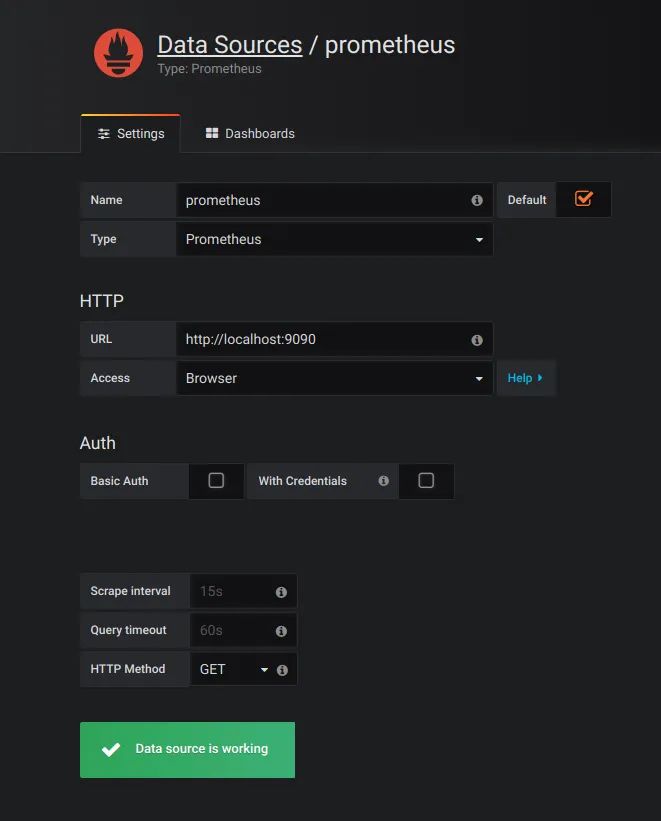
Name: prometheus
Type: Prometheus
URL: http://localhost:9090
Access: Browser
/api/datasources/proxy/),由Grafana的服务端来访问数据源的URL,如果数据源是部署在内网,用户通过浏览器无法直接访问时,这种方式非常有用。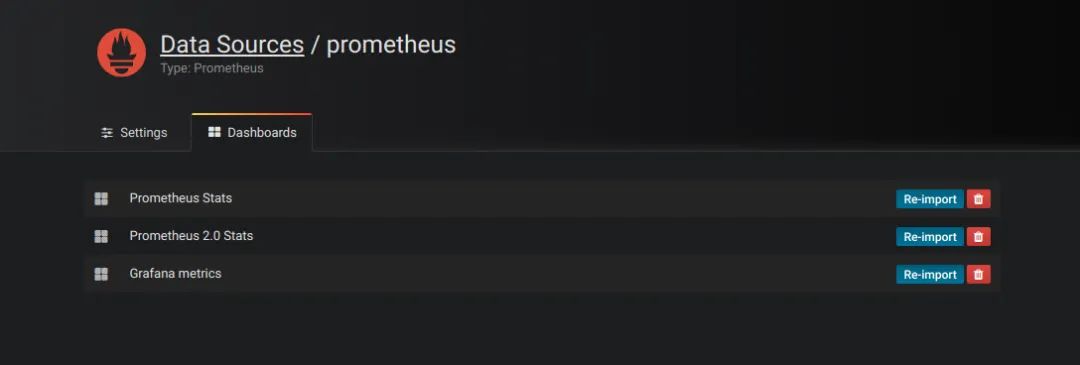
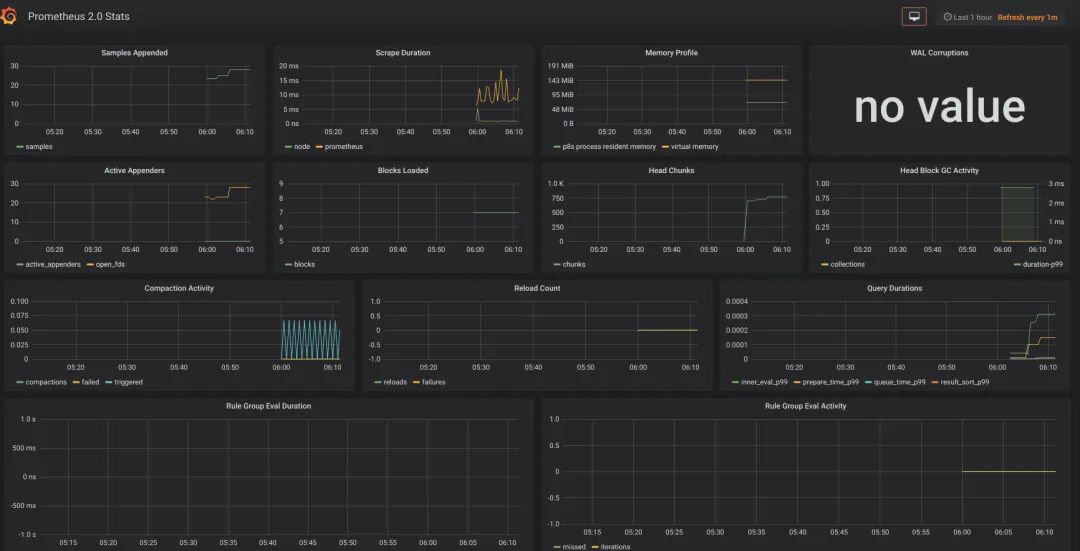
五、使用Exporter收集指标
5.1 收集服务器指标
$ wget https://github.com/prometheus/node_exporter/releases/download/v0.16.0/node_exporter-0.16.0.linux-amd64.tar.gz$ tar xvfz node_exporter-0.16.0.linux-amd64.tar.gz$ cd node_exporter-0.16.0.linux-amd64$ ./node_exporter
/metrics接口看看是否能正常获取服务器指标:$ curl http://localhost:9100/metricsscrape_configs中:scrape_configs:- job_name: 'prometheus'static_configs:- targets: ['192.168.0.107:9090']- job_name: 'server'static_configs:- targets: ['192.168.0.107:9100']
HUP信号也可以让Prometheus重新加载配置: killall -HUP prometheus
node_load1观察服务器负载: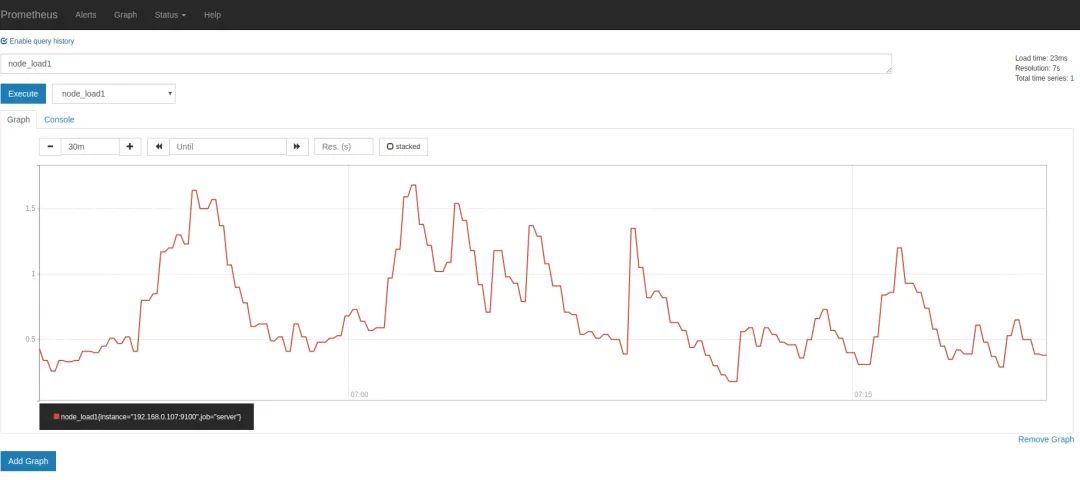
node exporter,有很多的面板模板可以直接使用,譬如:Node Exporter Server Metrics或者Node Exporter Full等。我们打开Grafana 的Import dashboard页面,输入面板的URL(https://grafana.com/dashboards/405)或者 ID(405)即可。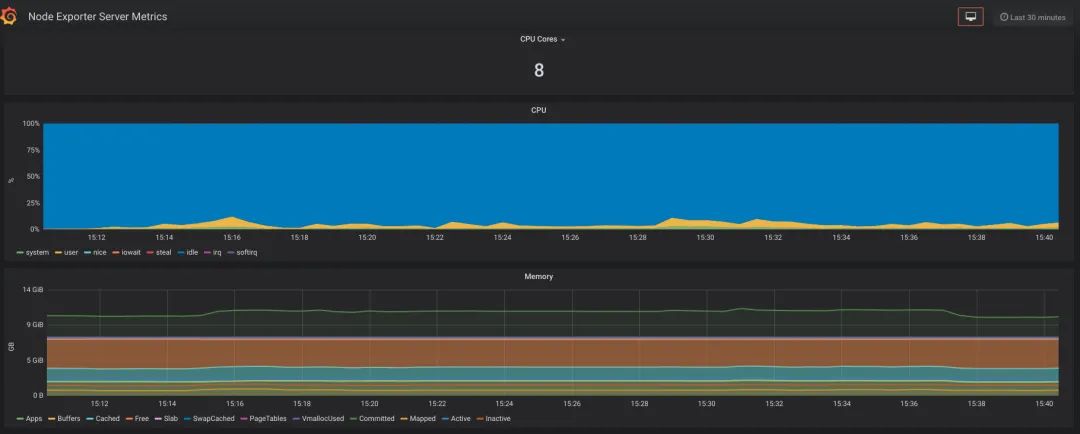
注意事项
docker run -d \--net="host" \--pid="host" \-v "/:/host:ro,rslave" \quay.io/prometheus/node-exporter \--path.rootfs /host
5.2 收集MySQL指标
$ wget https://github.com/prometheus/mysqld_exporter/releases/download/v0.11.0/mysqld_exporter-0.11.0.linux-amd64.tar.gz$ tar xvfz mysqld_exporter-0.11.0.linux-amd64.tar.gz$ cd mysqld_exporter-0.11.0.linux-amd64/
DATA_SOURCE_NAME,这被称为DSN(数据源名称),它必须符合DSN的格式,一个典型的DSN格式像这样:user:password@(host:port)/。export DATA_SOURCE_NAME='root:123456@(192.168.0.107:3306)/'./mysqld_exporter另一种方式是通过配置文
~/.my.cnf,或者通过--config.my-cnf 参数指定: ./mysqld_exporter --config.my-cnf=".my.cnf"$ cat .my.cnf[client]host=localhostport=3306user=rootpassword=123456
注意事项
CREATE USER 'exporter'@'localhost' IDENTIFIED BY 'password' WITH MAX_USER_CONNECTIONS 3;GRANT PROCESS, REPLICATION CLIENT, SELECT ON *.* TO 'exporter'@'localhost';
5.3 收集Nginx指标
/status/format/json接口来将vts的数据格式转换为Prometheus的格式。不过,在nginx-module-vts最新的版本中增加了一个新接口:/status/format/prometheus,这个接口可以直接返回Prometheus的格式,从这点这也能看出Prometheus的影响力,估计Nginx VTS exporter很快就要退役了(TODO:待验证)。/nginx_status可以获取一些比较简单的指标(需要开启ngx_http_stub_status_module模块);nginx_request_exporter通过syslog协议收集并分析Nginx的access log来统计HTTP请求相关的一些指标;nginx-prometheus-shiny-exporter和nginx_request_exporter类似,也是使用syslog协议来收集access log,不过它是使用Crystal语言写的。还有vovolie/lua-nginx-prometheus基于Openresty、Prometheus、Consul、Grafana实现了针对域名和Endpoint级别的流量统计。5.4 收集JMX指标
$ wget https://repo1.maven.org/maven2/io/prometheus/jmx/jmx_prometheus_javaagent/0.3.1/jmx_prometheus_javaagent-0.3.1.jar-javaagent参数来加载:$ java -javaagent:jmx_prometheus_javaagent-0.3.1.jar=9404:config.yml -jar spring-boot-sample-1.0-SNAPSHOT.jarconfig.yml是JMX Exporter的配置文件,它的内容可以参考JMX Exporter的配置说明 。然后检查下指标数据是否正确获取:$ curl http://localhost:9404/metrics六、告警和通知
6.1 配置告警规则
rule_files:- "alert.rules"
alert.rules:groups:- name: examplerules: # Alert for any instance that is unreachable for >5 minutes.- alert: InstanceDownexpr: up == 0for: 5mlabels:severity: pageannotations:summary: "Instance {{ $labels.instance }} down"description: "{{ $labels.instance }} of job {{ $labels.job }} has been down for more than 5 minutes." # Alert for any instance that has a median request latency >1s.- alert: APIHighRequestLatencyexpr: api_http_request_latencies_second{quantile="0.5"} > 1for: 10mannotations:summary: "High request latency on {{ $labels.instance }}"description: "{{ $labels.instance }} has a median request latency above 1s (current value: {{ $value }}s)"InstanceDown和APIHighRequestLatency。顾名思义,InstanceDown表示当实例宕机时(up === 0)触发告警,APIHighRequestLatency表示有一半的API请求延迟大于1s时(api_http_request_latencies_second{quantile="0.5"} > 1)触发告警。配置好后,需要重启下Prometheus server,然后访问http://localhost:9090/rules可以看到刚刚配置的规则:
http://localhost:9090/alerts可以看到根据配置的规则生成的告警:
PENDING,这表示已经触发了告警规则,但还没有达到告警条件。这是因为这里配置的for参数是5m,也就是5分钟后才会触发告警,我们等5分钟,可以看到这条alert的状态变成了FIRING。6.2 使用Alertmanager发送告警通知
/alerts页面可以看到所有的告警,但是还差最后一步:触发告警时自动发送通知。这是由Alertmanager来完成的,我们首先 下载并安装Alertmanager,和其他Prometheus的组件一样,Alertmanager也是开箱即用的:$ wget https://github.com/prometheus/alertmanager/releases/download/v0.15.2/alertmanager-0.15.2.linux-amd64.tar.gz$ tar xvfz alertmanager-0.15.2.linux-amd64.tar.gz$ cd alertmanager-0.15.2.linux-amd64$ ./alertmanager
http://localhost:9093/来访问,但是现在还看不到告警,因为我们还没有把Alertmanager配置到Prometheus中,我们回到Prometheus的配置文件prometheus.yml,添加下面几行:alerting:alertmanagers:- scheme: httpstatic_configs:- targets:- "192.168.0.107:9093"
http://192.168.0.107:9093。也可以使用命名行的方式指定Alertmanager:$ ./prometheus -alertmanager.url=http://192.168.0.107:9093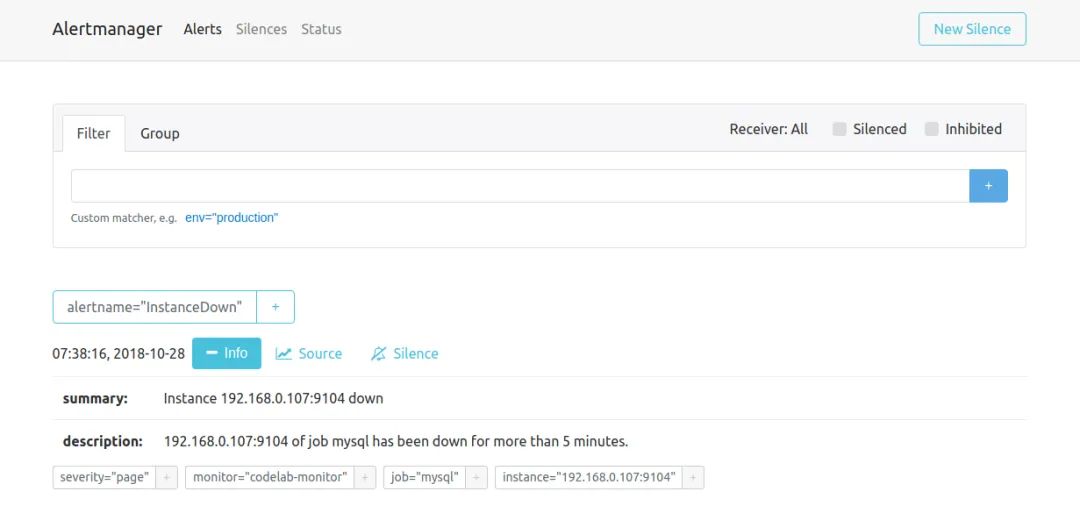
alertmanager.ym:global:resolve_timeout: 5mroute:group_by: ['alertname']group_wait: 10sgroup_interval: 10srepeat_interval: 1hreceiver: 'web.hook'receivers:- name: 'web.hook'webhook_configs:- url: 'http://127.0.0.1:5001/'inhibit_rules:- source_match:severity: 'critical'target_match:severity: 'warning'equal: ['alertname', 'dev', 'instance']
routes:- receiver: 'database-pager'group_wait: 10smatch_re:service: mysql|cassandra- receiver: 'frontend-pager'group_by: [product, environment]match:team: frontend
email_config
hipchat_config
pagerduty_config
pushover_config
slack_config
opsgenie_config
victorops_config
wechat_configs
webhook_config
七、学习更多
7.1 服务发现
7.2 告警配置管理
7.3 使用Pushgateway
总结
附录:什么是时序数据库?
增:需要频繁的进行写操作,而且是按时间排序顺序写入
删:不需要随机删除,一般情况下会直接删除一个时间区块的所有数据
改:不需要对写入的数据进行更新
查:需要支持高并发的读操作,读操作是按时间顺序升序或降序读,数据量非常大,缓存不起作用
InfluxDB:https://influxdata.com/ Kdb+:http://kx.com/ Graphite:http://graphiteapp.org/ RRDtool:http://oss.oetiker.ch/rrdtool/ OpenTSDB:http://opentsdb.net/ Prometheus:https://prometheus.io/ Druid:http://druid.io/

